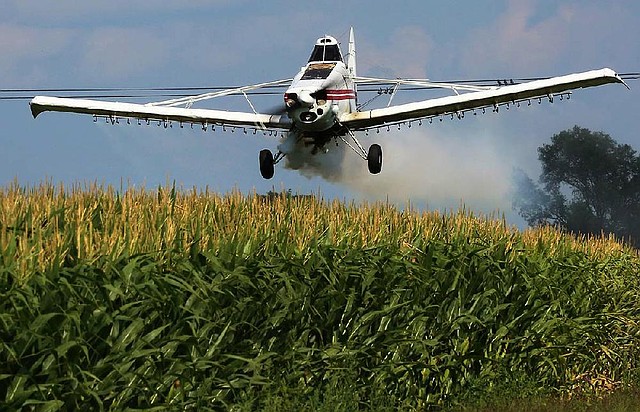Bumper corn, bean crops forecast
But bearish prices, lack of storage confront grain farmers
A pilot releases smoke to gauge wind direction during a crop-dusting demonstration over a cornfield earlier this month in Arlington, Wis. Field inspections show the U.S. corn harvest could be 1 percent more than a recent government estimate.
Saturday, August 23, 2014
The ripening corn and soybean fields stretch for miles in every direction from Dennis Wentworth's farm in Downs, Ill. As he marveled at his best-yielding crops ever, he wondered aloud where the heck he'll put it all.
RELATED ARTICLE
http://www.arkansas…">Hearing takes up defaults on grain
"Logistics are going to be a huge problem for everyone," the 62-year-old grower said, adding that he has invested in increasing output rather than grain bins. When harvesting starts in a few weeks, Wentworth expects his 150-year-old family farm to produce 10 percent more than last year's record. "There are going to be some big piles of grain on the ground this fall."
From Ohio to Nebraska, thousands of field inspections this week during the Pro Farmer Midwest Crop Tour show corn output in the U.S., the world's top producer, could be 1 percent more than a government estimate and soybeans 1.2 percent higher, according to a Bloomberg survey. Months of timely rains and mild weather created ideal growing conditions, leaving ears with more kernels than normal on 10-foot cornstalks and more seed pods on dark, green soybean plants.
Professional Farmers of America, a farming news and crop analysis firm, sponsors the annual summer tour across the nation's grain belt to gauge the size and health of crops.
Prospects of bumper harvests sent Chicago futures tumbling into bear markets last month, two years after a drought eroded output and sparked the highest prices ever. Cheaper grain is bolstering profit for buyers including Tyson Foods Inc. and Archer-Daniels-Midland Co., encouraging some cattle producers in the Great Plains to expand herds, and eroding income for farmers who say increased output will make up for some of the slump.
Corn on the Chicago Board of Trade has tumbled 20 percent since the end of May, touching $3.72 a bushel today, and soybeans are down 30 percent to $10.44 a bushel.
Samples in Illinois, Ohio, Indiana and Iowa -- representing 45 percent of forecast U.S. corn output and 41 percent of soybeans -- showed bigger yields than last year, according to inspections on the 22nd annual Pro Farmer crop tour, which ended Thursday. Corn production will be 14.178 billion bushels, compared with 14.032 billion estimated by U.S. Department of Agriculture, according to a survey of 13 tour participants. Soybean output was forecast at 3.861 billion bushels, compared with a USDA estimate of 3.816 billion.
The volunteer scouts on the four-day crop tour drove more than 15,000 miles across seven Midwest states, the biggest growing region, taking random samples by counting the number of kernels on corn ears and pods on soybean plants.
In Illinois, where the USDA predicted that corn yields will be 188 bushels an acre on average, the tour estimated 197 bushels an acre, up 16 percent from the same areas surveyed last year. In Iowa, preliminary samples showed 1,107 soybean pods per 3 square feet, up 18 percent from last year.
The outlook has improved after months of ideal weather. Through Aug. 16, the majority of the Midwest was slightly dry to abnormally moist, according to a weekly Crop Moisture Index from the National Oceanic and Atmospheric Administration. Temperatures that have been cooler than normal will remain average or below average through the end of August, the agency forecast.
The government already predicted record crops Aug. 12 and a drop in exports that will boost reserves, with corn output rising 0.8 percent and soybean production gaining 16 percent. The USDA will update its forecasts Sept. 11.
Prices have plunged to the lowest since 2010, with soybean futures in Chicago dropping to $10.35 Wednesday and corn slipping to $3.58 Aug. 12. Money managers have cut their bets on a corn rally by 75 percent since early April, and they have had a net-short holding in soybeans for five straight weeks, U.S. Commodity Futures Trading Commission data show.
Surging crop supplies may exacerbate the squeeze on grain storage and shipping. BNSF Railway Co., owned by Warren Buffett's Berkshire Hathaway Inc., and Canadian Pacific Railway Ltd. struggled with "greater-than normal" demand from shippers of coal, oil and Midwest crops, the USDA said this month in a report.
Combined with inventories left from the 2013 harvest, production of all grains and oilseeds will raise 2014 supply to 26.97 billion bushels, USDA data show. That's more than the 23.4 billion of storage on farms and grain-company silos as of Dec. 1, the government estimated in a Jan. 10 report.
"I don't know where it will all go this year," said Richard Guse, a 54-year-old farmer from Waseca, Minn., who owns a 1 million-bushel grain elevator that he expanded in the past year by 275,000 bushels. "We need better roads and faster train shipping to keep the grain moving," Guse said this week while inspecting fields as part of the Pro Farmer crop tour.
With the main harvest still weeks away, there is still time for crops to be damaged by weather, including an early frost. Parts of eastern and northwestern Iowa, the largest corn-growing areas, had less rain than normal over the past two weeks, QT Weather said in a report this week.
Not everyone is seeing better yields. Parts of Nebraska, Iowa and South Dakota had samplings that were less than last year. Ron Lampe's 2,100 acres in Cumminstown, Iowa, were flooded by 20 inches of rain in late June, forcing him to replant more than 10 percent of his cornfields and damaging some of those that survived.
Business on 08/23/2014
